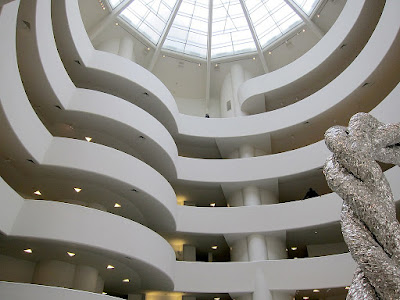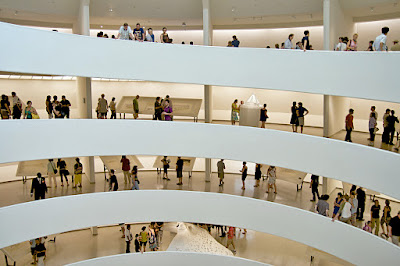Whoosh at Last! As Abq Jew has often mentioned (see January 2019's The L Train and The Jews) - he loves The New Yorker. Always has. Since he was a kid, just looking at the cartoons in his psychiatrists' offices.
Yes, every now and then David Remnick & Co turn out (what Abq Jew considers) a dud issue. But - 'way more often than not - there's a few articles (yes! they publish articles!) and several cartoons that brighten and/or inform Abq Jew's week.
So let's take a closer look at the issue of May 8, 2023. The one with not-yet-crowned-when-published King Charles III on the cover. But first - we've gotta talk about the Guggenheim Museum in New York City.
The Guggenheim
Wikipedia tells us -
The Solomon R. Guggenheim Museum, often referred to as The Guggenheim, is an art museum at 1071 Fifth Avenue between 88th and 89th Streets on the Upper East Side of Manhattan in New York City.
It is the permanent home of a continuously expanding collection of Impressionist, Post-Impressionist, early Modern, and contemporary art and also features special exhibitions throughout the year.
The museum's building, a landmark work of 20th-century architecture designed by Frank Lloyd Wright, drew controversy for the unusual shape of its display spaces and took 15 years to design and build; it was completed in 1959.
It consists of a six-story, bowl-shaped main gallery to the south, a four-story "monitor" to the north, and a ten-story annex to the northeast.
The main gallery contains a six-story helical rampthat extends along its perimeter, as well as acentral ceiling skylight.
Here is a video - featuring Sara Gore! - that provides a memorable introduction to the museum:
Now, Abq Jew does not wish to speak condescendingly to you, his loyal readers. (That means 'talking down' to you.) But Abq Jew must tell you (he must! he must!) that all New Yorkers already knew this.
That's because all New Yorkers then (1959) living, all New Yorkers ever born, and all New Yorkers ever to be born gathered near Mount Sinai Hospital right after Shavuot and learned all about The Guggenheim. And we all wondered -
What would it be like to
skateboard down the ramp?
Abq Jew fondly recalls that day (yes, just one day) in August 1968, just after the Soviet Union's invasion of Czechoslovakia, when Abq Jew (figuratively, not literally) put on his roller skates to visit Mona Lisa, Venus de Milo, and Winged Victory at The Louvre.
But that was different.
Winged Victory
As Cole Louison so trenchantly describes in that May 8, 2023 issue of The New Yorker. Published with the headline
“Whoosh”
And which Abq Jew now displays in its entirety, in complete violation of an entire plethora of US copyright laws, UN resolutions, and international conventions.
Please, copyright lawyers, consider this fair use - or even a free promotion!
♦
Illustration by João Fazenda
Skating the Gnarliest Ramp of Them All: The Guggenheim
The six-story spiral tempted would-be shredders for six decades, until the museum finally allowed the skateboarder Alexis Sablone in for a night.
At any given time, the Guggenheim may host Kandinskys, Picassos, Pollocks, Mondrians, or af Klints, but the first thing that any visitor who isn’t too boring to admit it thinks about is the ramp, and how much fun it would be to roll down. Frank Lloyd Wright imagined the museum’s six-story helix as
“a curving wave that never breaks.”
The building opened in 1959, the same year that the Roller Derby Skate Board débuted. And yet, for the next six decades, perhaps owing to a sense of decorum, or to a competent security crew, no one skated down the ramp.
“A ramp like that—it’s breathtaking,”
the professional skateboarder Alexis Sablone said the other evening.
She was standing on the museum’s ground floor, a board at her hip. Converse, one of Sablone’s sponsors, had persuaded the Guggenheim to allow the company to shoot a film, promoting Sablone’s signature shoe, using the ramp.
The talks took nearly a year; Sablone was kept in the dark.
into Times Square and unveil a billboard.”
She looked around, dropped her board, and popped an awkward ollie.
Sablone grew up in New England, where she skated parking lots and garages. As a teen-ager, she starred in “Wonderful, Horrible, Life,” a gritty skate film shot on handheld cameras around Boston, where skateboarding is banned on public property. She is now thirty-six, with short black hair, and lives in Crown Heights.
In addition to skating (she placed fourth in the street classification at the Tokyo Olympics), she’s an artist and a designer, with a master’s in architecture from M.I.T.; she recently made a 3-D model of the Guggenheim on her computer.
The plan was to shoot Sablone in black-and-white sailing down the ramp. “The building is a simple idea,” the director Jeremy Elkin, who wore an orange shirt and a black cap, said. “The piece has to reflect that. That ethos.”
Workers were humping several trucks’ worth of gear up the ramp: lights, tripods, sandbags, Spidergrips, an Arri Alexa camera, an Easyrig that looked like a mechanical giraffe. The walls were bare; the art works had been stored in crates on the ground floor.
The oculus was dark. Sablone warmed up, landing a few kickflips. She slipped while doing a Nollieheel, landing on her butt, then lay back, looking up. Far above, a camera peered over the railing. Elkin’s radio crackled.
“O.K.!” he said. “Let’s go!”
At around 11 p.m., Sablone rode the elevator to the top floor (Wright didn’t want visitors to walk up) for a test shot, a simple left-to-right roll through the frame. The shot looked nice—a series of black, white, and gray horizontal curves, from which Sablone emerged like a fin—but there were issues.
Sablone didn’t want to look down.
“It would make me dizzy,” she said.
“The only flat surface is the ground,
so you have no reference points
for where you are in space.”
She’d also discovered that the ramp was coated in a layer of what she likened to “Masonite dust,” which stuck to her wheels. The skating was fast; the ramp was surprisingly steep.
“The amount of curvature, the only thing you
can compare it to is a parking garage,
honestly,” she said.
During the test shot, she’d almost rammed a protrusion.
“I don’t want to be the first skateboarder to skate
the ramp and the first skateboarder
to break the museum,” she said.
Elkin repositioned the crew and made a new plan. Sablone would start at the top and roll down to the next floor for a full orbit, but stop at the balcony. Then the production would move down a floor and start again.
Sablone bounded back up and retook her starting place. Elkin called,
“Action!”
Sablone stepped on her board and started rolling. The rotunda filled with a humming buzz that grew louder as she picked up speed. She leaned like a surfer.
Elkins got the shot, and the crew trudged down the ramp to repeat the drill. They wrapped at around 7 a.m., as the oculus was filling with light. Sablone, damp with sweat, was limping slightly.
“I grew up skating in the nineties,” she said, smiling.
“I never, ever would expect to be here.”
♦








No comments:
Post a Comment